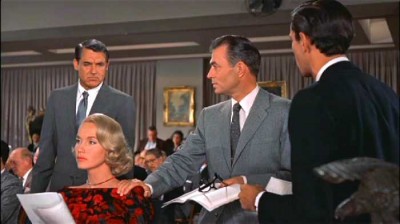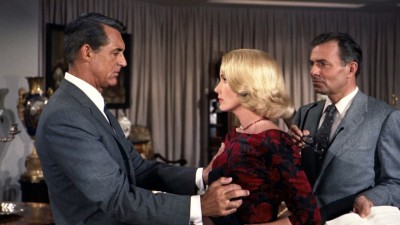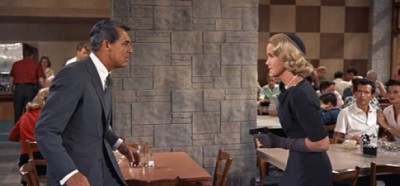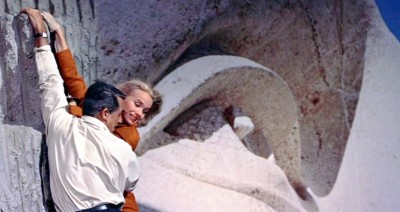
North by Northwest (1959) is the last Alfred Hitchcock film that can fairly be called straightforward entertainment. Everything that came after it at least attempted to be more than pure entertainment. For that matter, a good many of the 1950s films that preceded it had also been weightier in tone. When Hitchcock made the film, it came on the heels of The Wrong Man (1956) and Vertigo (1958) — two movies that did Hitch no favors at the box office. North by Northwest is a return to more tried-and-true romantic-comedy thriller material, but is hardly a retreat. Rather, it’s the filmmaker’s final statement on a favorite concept — the innocent man on the run for a crime he did not commit, a premise Hitchcock had been mining since The 39 Steps in 1935. Here, he would take that idea to new extremes — and in wide-screen (VistaVision) Technicolor with all the gloss MGM could muster. Who could ask for more?

Armed with Ernest Lehman’s Hollywoodized screenplay, Hitchcock managed to turn an essentially 1930s idea into a very contemporary comic thriller. The manner in which Cary Grant’s Madison Avenue advertising executive, Roger O. Thornhill, is mistaken by spies for a non-existent U.S. agent would be right at home in an Astaire-Rogers picture. Making Grant an advertising man — a much derided profession even then — was a masterstroke. His Thornhill is a charming but shallow fellow — he even claims the middle initial “O” stands for nothing (a Hitchcock dig at producer David O. Selznick’s meaningless initial) — so shallow, in fact, that he really has no identity until he’s mistaken for the fictitious American spy George Kaplan. (Kaplan is an FBI fabrication meant to mislead foreign agents.) It’s a neat trick — a man with no particular identity becomes a man who doesn’t exist (at least in the minds of the foreign agents).

The plot proper doesn’t really kick in until Thornhill is tagged with the murder of a United Nations contractor — the event that sends him on the run from the police and on the search for the “real” Kaplan. This is also what gets him onboard the Twentieth Century Limited bound for Chicago, where he meets Eve Kendall (Eva Marie Saint). We’re very nearly right back to Robert Donat meeting Madeleine Carroll in The 39 Steps, but in highly sexualized terms (at least as far as 1959 censors allowed) — and with a lady of considerably greater complexity than Carroll’s virginal ingenue. But in essence that’s what all this is — a modernized and more complex variation on Hitchcock’s earlier success.

The famous cornfield sequence is an elaboration on Donat being pursued across the Scottish moors — with the business of a plane “dustin’ crops where there ain’t no crops” being a nod to the windmill turning the wrong direction in 1940’s Foreign Correspondent. The auction-house scene is a reworking of Donat being mistaken for a parliamentary candidate and having to give an impromptu speech. Master spy Phillip Vandamm (James Mason) is a new version of Godfrey Tearle’s Professor Jordan from The 39 Steps. And so it goes, though the big climax on Mount Rushmore owes more to Hitchock’s 1942 39 Steps variant Saboteur with its Statue of Liberty climax — only here it’s bigger and more suspenseful.

In reality, North by Northwest is simply a deliberate attempt to create the ultimate Hitchcock picture — and while it may not quite pull that off, it comes so close that complaining seems like nitpicking. As sheer entertainment goes, it’s a tough act to follow — and maybe that’s why Hitchcock never tried. And no one else has ever quite come near it.
The Asheville Film Society’s Big Screen Budget Series will show North by Northwest Wednesday, June 19, at 7:30 p.m. at The Carolina Asheville (downstairs). Admission is $5 for AFS members and $7 for the general public.




Would that movies this thrilling were made today. And without any f***ing CGI. It was made to be seen on a 70mm screen and I’m glad I got to see it that way.
I would expect the turnout for this to rival the crowd that gathered for The Shining. I certainly had a good time with it when I saw it on the big screen 8 or 9 years ago.
I bought a Blu-Ray player so I could watch the latest restoration of this on it. It looks gorgeous and I’d recommend all your Ashvillains get out to catch it on a bigger screen.
It was made to be seen on a 70mm screen and I’m glad I got to see it that way.
But it wasn’t made in 70mm. MGM wanted it to be (and may have blown it up to that at some point), but Hitchcock opted to shoot it in Paramount’s VistaVision process on 35mm.
Well, it seemed like it. I saw it at one of the bigger theaters with my parents but I was only about 11 years old. In any case it screams to be seen on a big screen.
I would expect the turnout for this to rival the crowd that gathered for The Shining.
We shall see. I take it you will not be there.
It looks gorgeous and I’d recommend all your Ashvillains get out to catch it on a bigger screen.
This should be on the biggest screen in the theater (the one you saw the Herzog film on) — and even better than a Blu-ray.
Well, it seemed like it. I saw it at one of the bigger theaters with my parents but I was only about 11 years old. In any case it screams to be seen on a big screen.
Oh, I agree it deserves to be seen on the big screen — in part because it was made with that in mind. And in 1959, screens tended to be bigger than the are now simply because most (maybe all) theaters were single screen affairs designed to seat at least 500 folks or thereabouts. (I don’t know when muliplexes first happened. The first one I encountered was the AMC Varsiy Six in Tampa in 1974.)
But then VistaVision was a wonderful format for sharpness. It provided a semi-widescreen image of 1.85:1 with a lot less grain than anamorphic true 2.35:1 widescreen. The film ran through the camera horizontally allowing a larger image on the negative from side to side. Of course, this’ll be running from a DCP, but the sharpness in the original negative will be retained.
I take it you will not be there.
Alas, no. Hoping to catch Barcelona though. But only if I’ve got Before Midnight watched by 8 o’clock Tuesday.
Speaking of, I need to figure when S and I will squeeze in Sunrise and Sunset revisits. Heh – movie deadlines are my favorite kind of deadlines. But then again, I don’t do this professionally…
I would advise against it — doing this professionally, I mean.
C’mon now, you seem like a happy person.
Deep down.
I think that’s a compliment. Maybe.
Hoping to catch Barcelona though. But only if I’ve got Before Midnight watched by 8 o’clock Tuesday.
You failed.
We actually caught Before Midnight on Tuesday afternoon. Which I realize only makes my no call/no show an even more glaring offense.
Wound up going out for a sort of low-key birthday celebration instead, since I’m stuck working my birthday proper.
Very much enjoyed Midnight — certainly more so than Before Sunset, and maybe even as much as Before Sunrise. Revisiting the first in the series actually improved my already high opinion of it, while re-watching the second dispelled a good deal of my affection toward it. (Though I wouldn’t say it quite brought my feelings for it down to your level– or at least from what you original review would indicate.)
How was the turnout for Barcelona? Would you say it played noticeably better or worse than Metropolis?
I suppose you think this birthday jazz is going to expiate your sins, huh? Like seeing Barcelona wouldn’t have qualified for “low-key birthday celebration?”
The turnout for Barcelona was better — though very few had been to Metropolitan (I didn’t ask if they’d come to Metropolis [you didn’t think I’d let that slip past, didja?]). The response, however, was noticably cooler. Didn’t we just lose two viewers last time? We lost four this round. And the attempt a few made at applauding was rather sad.